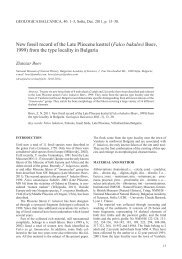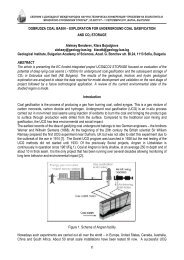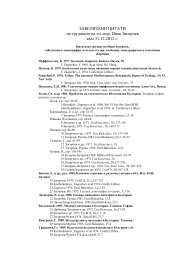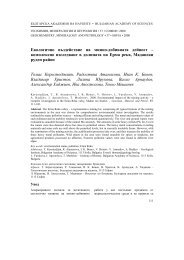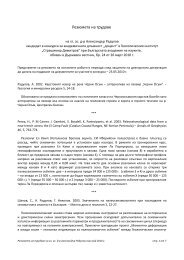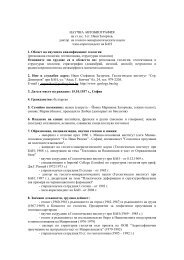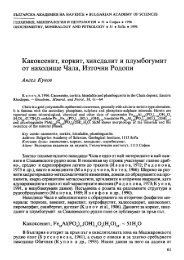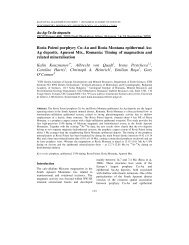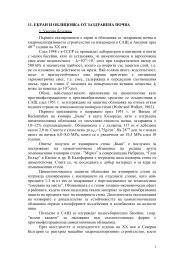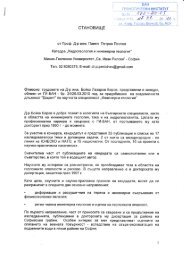2: Hydrothermal ore deposits related to post-orogenic extensional ...
2: Hydrothermal ore deposits related to post-orogenic extensional ...
2: Hydrothermal ore deposits related to post-orogenic extensional ...
You also want an ePaper? Increase the reach of your titles
YUMPU automatically turns print PDFs into web optimized ePapers that Google loves.
66<br />
enriched or veined mantle xenoliths from the lithospheric<br />
mantle entrained in the late intraplate basalts<br />
(Marchev et al., 2004a). In the light of the geological<br />
setting and tec<strong>to</strong>nic his<strong>to</strong>ry summarized above, this<br />
late <strong>orogenic</strong> magmatism was m<strong>ore</strong> probably triggered<br />
by <strong>post</strong>-collisional extension (Chris<strong>to</strong>fides et<br />
al., 1998; Harkovska et al., 1998a; Marchev et al.,<br />
1998a, 2004a). The geochemical complexity of the<br />
late <strong>orogenic</strong> Rhodopean magmas can be ascribed <strong>to</strong><br />
a combination of partial melting of an OIB-like<br />
enriched mantle, chemically and iso<strong>to</strong>pically modified<br />
in the Rhodope metamorphic basement through<br />
the processes of crustal contamination, fractional<br />
crystallization, and magma-mixing (Marchev et al.,<br />
1989, 1994, 1998a, 2004a; Harkovska et al., 1998a).<br />
The order of emplacement of the mafic rocks in the<br />
Eastern Rhodopes, from high-Ba trachybasalts,<br />
through shoshonites, calc-alkaline and high-K calcalkaline<br />
basalts, <strong>to</strong> purely asthenosphere-derived<br />
alkaline basalts, with a progressive decrease in the<br />
crustal component, has been interpreted <strong>to</strong> reflect<br />
upwelling asthenospheric mantle as the result of convective<br />
removal of the lithosphere by a mantle diapir.<br />
This explains the surprising similarity with processes<br />
of extension and magma evolution in the Western<br />
U.S. Cordillera and in the Menderes Massif in SW<br />
Turkey (Marchev et al., 2004a).<br />
4. <strong>Hydrothermal</strong> base and precious metal <strong>deposits</strong><br />
The Rhodope Massif, like the entire Macedonian–<br />
Rhodope–North-Aegean Magmatic Belt, is characterized<br />
by numerous small <strong>to</strong> moderate-sized polymetallic<br />
<strong>ore</strong> <strong>deposits</strong> of variable composition and <strong>ore</strong><br />
type, some of which are grouped in<strong>to</strong> <strong>ore</strong> districts of<br />
global significance (S<strong>to</strong>yanov, 1979; Mitchell and<br />
Carlie, 1994; Mitchell, 1996). Major <strong>ore</strong> <strong>deposits</strong><br />
are localized at the eastern part of the Central Rhodopes<br />
and are absent in the western part of the<br />
Central Rhodopes, which are characterized by few<br />
small Pb–Zn and Sb <strong>deposits</strong> (Dimitrov, 1988;<br />
Dokov et al., 1989). The distribution and key characteristics<br />
of four major <strong>ore</strong> types are summarized<br />
below, m<strong>ore</strong> detailed descriptions of two examples<br />
being presented in Box 2–1 (Vassileva et al., 2005,<br />
this volume) and Box 2–2 (Marchev et al., 2005, this<br />
volume).<br />
P. Marchev et al. / Ore Geology Reviews 27 (2005) 53–89<br />
4.1. Metamorphic-hosted vein and replacement<br />
Pb–Zn–Ag <strong>deposits</strong><br />
His<strong>to</strong>rically the most significant <strong>ore</strong> <strong>deposits</strong> in<br />
Bulgaria are Pb–Zn-dominated veins and marblereplacement<br />
bodies hosted by basement metamorphic<br />
rocks in the roof of large <strong>extensional</strong> domes. They are<br />
also associated with silicic dyke swarms, and their<br />
precise temporal and genetic relation <strong>to</strong> c<strong>ore</strong> complex<br />
formation and acid magmatism are a subject of recent<br />
study (Kaiser-Rohrmeier et al., 2004).<br />
Ore fields associated with the Central Rhodopean<br />
Dome include Madan, Laki, Davidkovo, Eniovche<br />
and Ardino in Bulgaria, and Thermes as a continuation<br />
of the Madan <strong>ore</strong> field in Greece (Fig. 3, Box 2–<br />
1; Vassileva et al., 2005, this volume). Together, these<br />
comprise about 70 individual <strong>deposits</strong>. In <strong>to</strong>tal, ca.<br />
114 Mt of Pb–Zn <strong>ore</strong> was processed from all <strong>ore</strong> fields<br />
between 1941 and 1995 (Table 5, Milev et al., 1996).<br />
Silver content in the <strong>ore</strong>s varies between 12 and 53 g/<br />
t, except for higher values, up <strong>to</strong> 160 g/t, in the Ardino<br />
region. Presently, underground operations are active<br />
in the Laki and Madan <strong>ore</strong> fields.<br />
The <strong>deposits</strong> comprise hydrothermal Pb–Zn veins,<br />
disseminated vein s<strong>to</strong>ckworks, and metasomatic replacements<br />
as the economically most important <strong>ore</strong>bodies.<br />
All <strong>ore</strong> fields are spatially associated with the<br />
inferred detachment fault (Kaiser-Rohrmeier et al.,<br />
2004). The Madan <strong>ore</strong> field is located on the western<br />
slope of the dome, the Laki <strong>ore</strong> field on the northern<br />
slope and the Eniovche and Ardino <strong>deposits</strong> are<br />
located in the eastern periphery. Davidkovo is situated<br />
on the culmination of the dome less than a kilometre<br />
from the inferred but eroded hanging-wall detachment.<br />
There, the <strong>ore</strong> veins are hosted by homogenous<br />
gneisses and several marble horizons, as well as silicic<br />
dykes and volcanoclastic rocks. Mineralization is<br />
developed in s<strong>to</strong>ckworks and veins up <strong>to</strong> 3 m thick<br />
at the intersections of three NW-, E- and NE-trending<br />
fault structures in the footwall of the dome (Dragiev<br />
and Danchev, 1990; Ivanov et al., 2000). Veins invariably<br />
cut the detachment fault, and mineralization<br />
locally extends in<strong>to</strong> overlying conglomerates of <strong>extensional</strong><br />
basins. In the Madan <strong>ore</strong> field (Box 2–1; Vassileva<br />
et al., 2005, this volume), the <strong>deposits</strong> are<br />
closely <strong>related</strong> <strong>to</strong> six major subparallel NNW-trending<br />
faults, the most extensively developed mineralization<br />
being controlled by the intersection with WNW-trend-



